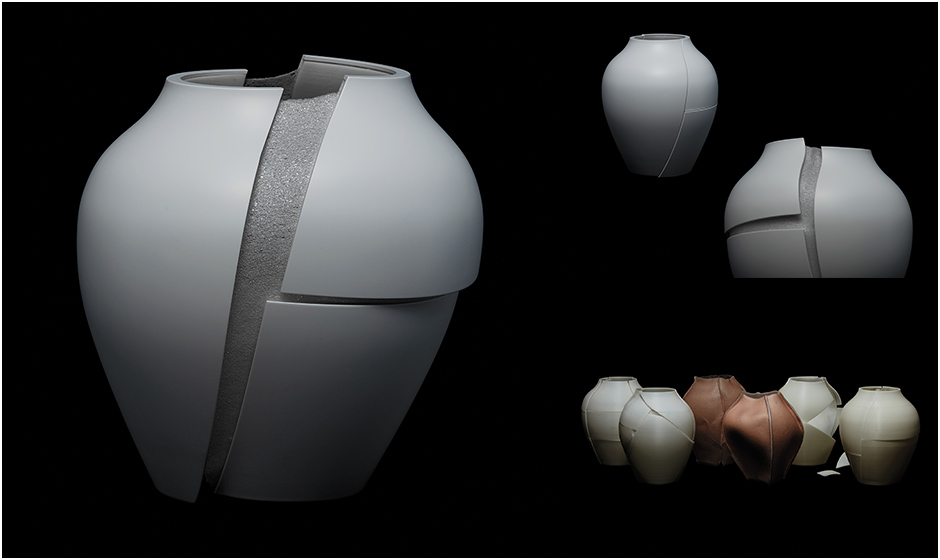
#006
The Shape
Memory Sheet meets TAKU SASAKI
「UNFRAGMENT」
- KOKUYO Creative Center
- TAKU SASAKI
Developed by Mitsui Chemicals Tohcello, Inc., the Shape Memory Sheet has the unique ability to become hard when cold, then become more flexible when exposed to the warmth of the human hand.
Taku Sasaki of KOKUYO Co., Ltd. has used this peculiar characteristic to create a new product: “UNFRAGMENT.”
Using the Shape Memory Sheet to Make
“The Vase That’s Already Broken”
I felt that the Shape Memory Sheet had the potential to go up against the idea that something that’s broken is worthless. When I first got my hands on the material, I was interested in its unique texture – it feels almost like mochi. And so I set out on a trial-and-error process to make a new product using this flexibility. It wasn’t until the middle of this process, however, that I realized I could put extra emphasis on the material’s stretchability by combining a material that does not stretch.
I started out by sticking flat layers of thick paper or leather to the sheet. But when I tried turning that into a 3D cone shape, I got something that neatly returned to its original state after being stretched. And that motion, I thought, was something interesting. That led me to think whether I could possibly use this characteristic with the nuance of a product “returning to normal.” I then decided to make a vase that was broken into parts to begin with.
One thing I kept in mind was the traditional kintsugi technique of fixing broken pottery. By using lacquer and gold to join broken parts back together, it is a technique that allows for an old piece of pottery to become even more valuable than it was before it broke. This project is similar: by applying the Shape Memory Sheet to the cracks, it becomes possible to insert something larger than the vase’s opening into the vase, enclosing it inside.
With this, I wondered whether I could take the material’s quirk of expanding and returning to normal and turn it into a positive, creating new value that goes against the common-sense assumption that something that’s broken is worthless.
In working toward this goal, I experimented with Shape Memory Sheets of different thicknesses and colors – as well as with changing the shape of the cracks – to try out different kinds of stretching. Ultimately, I lowered the adhesion area between the Shape Memory Sheet and the vase to allow more parts to move, and I simplified the shape of the cracks. These changes caused the product to neatly stretch and return to normal.
Whenever I design, I tend to keep in mind a set of design rules that work with the properties of the material. So if I’m using wood, for example, I have a set of rules that works with those properties; if I’m using iron, I’ve got another set of rules for that. But with a new material like this, I had to start from an earlier stage: thinking of what the best way to treat the material even was. There aren’t any rules for it yet, and so I thought I might be able to come up with a completely new idea.
Going with that idea then also meant challenging the preconception of what a product is. Most people will buy a finished product without any thought. But maybe, I considered, it’s fine if the product’s not actually finished. Would it be OK to have a new product that’s not finished as soon as you get it? That’s the sort of thing that came to mind as I was moving forward with this project.
About the material
The Shape Memory Sheet, a new product developed by Mitsui Chemicals Tohcello, takes a special Mitsui Chemicals polymer, foam it, and turning it into a sheet. It has captivated a wide range of people since it first entered into sample testing. Feedback has come in with descriptions of the product offering “an entirely new texture,” saying that it makes one “want to just keep holding it” and that “the way it slowly returns to normal is really unique.”
Coming in sheet form, the material has shape memory characteristics that allow it to return to normal even if stretched, rolled up or crumpled. Its high temperature dependence causes it to become hard at low temperatures but have increased flexibility when between normal temperatures and 50 degrees Celsius. As a result, any part of the sheet being touched by a person will become flexible, while parts not being touched are somewhat harder, producing the feeling of support by the material.
The fact that the material changes when being touched has created high hopes for its use in entirely unique product development. This could include the material fitting to consumers in applications such as health care, medical treatment, nursing and sports, as well as in various seats, cushions and beds.
In other characteristics, the Shape Memory Sheet is supple enough that its own weight causes it to change shape when lifted up. The material also offers elasticity, transforming under pressure and then maintaining that transformed shape for a period of time before slowly returning to its original shape. And despite being a foam product, the sheet’s closed-cell structure stops water from passing through or being absorbed.
It is also possible to stick or sew the Shape Memory Sheet together with other cloths or sheets. And this is true whether these are made with commonplace natural materials such as leather and linen or synthetic materials such as polyamides, polyester and polyurethane.
This then allows samples of such composite materials to be provided with not only the added qualities of gentle stretching and flexibility but, moreover, a new added value through their unique way of returning to their original shape. Further, by exposing the material to heat in the neighborhood of 100 degrees Celsius and forming it, the material can be made to remember these shapes.
This new functional material therefore makes it possible to offer further added value by conducting various processes – including sewing or sticking materials together, vacuum forming, print forming and more.
- Taku Sasaki / Creative center, KOKUYO Co., Ltd.
- Born in Tokyo in 1985, Taku Sasaki graduated from Tama Art University with a major in product design in 2008 before joining KOKUYO.
Sasaki previously won the KOKUYO Design Award in 2005, as well as a special category of the same award in 2014. He now works at THINK OF THINGS, which KOKUYO opened as a directly managed store in 2017 in Sendagaya, Tokyo. His work here includes being in charge of direction and design for original products. On his days off, Sasaki works on the B6studio product design project. 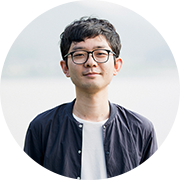
- Movie/Shinsuke Sugino
- Original Music/Tetsuro Yasunaga
- photo/Toru Oshima

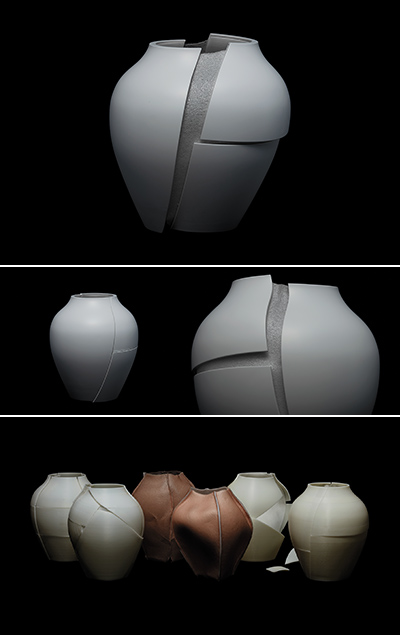
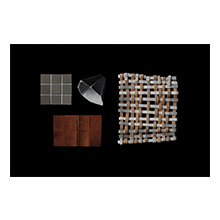
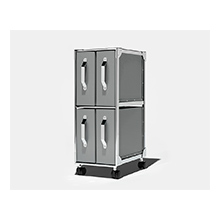
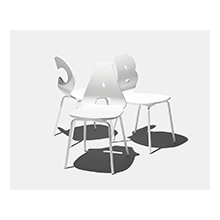
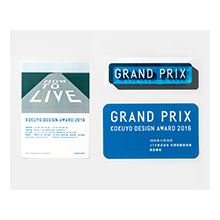
COMMENT
Industrial Film &
Sheet Business
Division,
Mitsui Chemicals
Tohcello, Inc.
For this project, KOKUYO’s Taku Sasaki paid close attention to the Shape Memory Sheet’s shape memory characteristics, as well as to its varying flexibility under different temperatures. This then saw him propose a design that combined a hard material with a soft material for a vase that would return to its original shape. His idea to open up cracks in the hard material and use this, however, came as a surprise.
Paying homage to the traditional kintsugi technique of repairing a broken vase to give it additional value, Sasaki created a vase that opens up when spread out by a person’s hands, then naturally returns to the kintsugi-repaired original state. This depiction of a product that goes back and forth between broken and repaired states then also represents time going back and forth between the present and future.
In order to realize this concept, we went through a process of trial and error, using this to look into adhesion methods, the vase’s shape and more. But we were touched by just how well the end result – the moment at which the vase returns to its original shape – shows off the shape memory characteristics of the Shape Memory Sheet.
We would be thrilled if Sasaki’s project were to inspire even more people with the Shape Memory Sheet’s unique appeal, leading to the creation of further value.